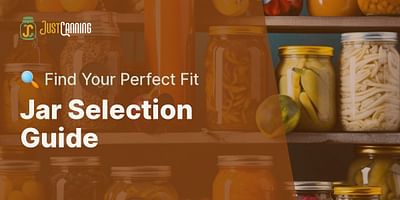Martha Greenfield is a seasoned home canner with over 20 years of experience. She loves sharing her knowledge on preserving fruits and vegetables. She has a knack for creating delicious and unique recipes that are easy to follow.
Welcome to your mason jar canning guide! As a seasoned home canner, I can't stress enough the importance of properly sealing mason jars for canning. It's not just about preserving your delicious homemade goods; it's also about ensuring their safety for consumption. So, what are the steps to seal mason jars?
Firstly, you'll need to gather your canning supplies. This includes mason jars, lids, and a canner. Next, you'll need to prepare your jars and lids by cleaning and sterilizing them. Then, you'll fill your jars with your chosen food items, making sure to leave the appropriate headspace.
Applying and tightening the lids is a crucial step. You'll place the lid on the jar, apply the screw band, and adjust for the correct tightness. Then, it's time to process your jars in the canner. But how do you use a steam canner? And what are the steam canning times? Don't worry, we'll cover these questions too!
Finally, you'll store your canned goods in a way that ensures they remain sealed and safe to eat. And remember, while you can reuse canning lids, it's essential to understand the proper canning methods to do so safely. Ready to dive in? Let's get canning!
🥫Let's Gather Your Canning Essentials: Mason Jars, Lids, and More!
Before we dive into the nitty-gritty of sealing mason jars, let's make sure we have all the necessary tools and materials. Naturally, you'll need canning mason jars. These come in various sizes, so choose the one that best suits your needs. If you're unsure about where to find the best jars, check out our guide to the best canning jars at Walmart. Next, you'll need canning lids and bands. Remember, while you can reuse the bands, the lids should always be new to ensure a proper seal. If you're wondering about the purpose of canning lids, we have an FAQ on the purpose of canning lids that you might find helpful.
Have you ever heard of a steam canner? This handy tool is a game-changer in the world of canning. It uses steam to process your jars, making it a more energy-efficient option than traditional water bath canning. If you're new to this method, our guide on steam canning can be a great place to start. Plus, it's a real time-saver! You'll also need a jar lifter to safely handle hot jars, a funnel to fill jars neatly, and a bubble remover to eliminate air bubbles inside the jars.
Proper canning methods require some additional items like a clean cloth for wiping jar rims and a timer to keep track of processing times. And, of course, you'll need your chosen food items to can. If you're new to canning and need some guidance, you might find our FAQ on how to begin canning food at home useful. Ready to get started? Let's move on to preparing your mason jars and lids.
🧼Prep Time: Cleaning and Sterilizing Your Mason Jars and Lids
Now, let's get those mason jars and lids ready for canning. First, wash your mason jars, lids, and screw bands in hot, soapy water. Rinse them thoroughly to ensure no soap residue remains. This is an essential step in our mason jar canning guide to prevent any unwanted flavors in your preserved goods.
Next, to sterilize, place the jars on the rack of a steam canner or a large pot filled halfway with water. Make sure the jars are fully submerged and upright. Bring the water to a gentle boil and let the jars sit for 10 minutes. If you're at an altitude of 1,000 feet or more, add an extra minute of sterilizing time for each 1,000 feet of elevation. For more information, check out our guide on how to sterilize canning jars without using a canner.
While the jars are sterilizing, place the lids in a separate saucepan, cover them with water, and bring to a simmer. Keep them hot until you're ready to use them. Remember, proper canning methods don't require boiling the lids, as explained in our FAQ on boiling canning lids. And here's a tip: while you can reuse canning jars, it's best not to reuse canning lids as they may not seal properly the second time around, as discussed in our FAQ on reusing canning lids.
Once sterilized, use a jar lifter to remove the jars, draining any water back into the canner. Place them on a clean towel to cool. Now, you're all set to fill them up!
🍓Filling Up: How to Properly Load Your Mason Jars
Now that your mason jars are clean and ready, it's time to fill them up! Start by placing your chosen food items into the jars. Whether you're canning fresh peaches or homemade salsa, make sure to pack the contents tightly to maximize space. However, remember to leave the appropriate headspace - that's the gap between the top of the food and the top of the jar. This is crucial for proper sealing during the canning process.
But how much headspace is just right? Well, for most fruits and pickles, a half-inch space is ideal. For non-liquid items like meats and vegetables, aim for a generous one-inch headspace. This allows for expansion during the steam canning process.
Got your headspace sorted? Great! Now, remove any air bubbles by gently running a non-metallic spatula around the inside of the jar. This step ensures a tighter pack and helps prevent food discoloration. The art of canning mason jars is all about these little details, wouldn't you agree?
🔩Securing the Deal: Applying and Tightening Your Canning Lids
Now that your mason jars are filled and ready, it's time to secure the deal. The next step in our mason jar canning guide is applying and tightening the lids. This is a crucial part of the proper canning methods as it ensures the contents of your jar are preserved and safe to eat. To understand more about the importance of this step, you can read our article on 'Safety First: Common Canning Mistakes That Can Kill You and How to Avoid Them'.
First, place the lid on the jar. Make sure it's centered and fits snugly on the rim. Next, apply the screw band. It should be finger-tight, which means you only tighten it as much as you can using your fingers, no tools needed. Over-tightening can prevent the air from escaping during the canning process, which we definitely don't want.
Are you wondering about the correct tightness? A good rule of thumb is to screw the band until it's tight, then turn it back a quarter-inch. This allows enough room for the air to escape during the steam canning process. And remember, you can't reuse canning lids as they won't seal properly the second time around. Always use new lids to ensure a good seal. For more information, check out our FAQ on 'How many times can mason jar lids be reused in canning'.
Following these steps to seal mason jars will ensure your canned goods stay fresh and delicious. If you're unsure about whether your jars are sealed properly, you can refer to our FAQ on 'How can I determine if my canning jars are properly sealed'. Ready for the next step?
🔥Into the Heat: Processing Your Mason Jars in the Canner
Now that your mason jars are filled and the lids are securely in place, it's time to move on to the canning process. This is where your steam canner comes into play. But first, let's understand what is steam canning. It's a method that uses steam in a sealed container to heat and thus, preserve the food in your jars.
Begin by placing your jars in the steam canner. Make sure the water level is correct according to your steam canner instructions. Once everything is set, close the lid and turn up the heat. As the water boils, it will create steam that envelops and heats your jars, sealing them in the process.
But how do you know when the jars are properly sealed? You'll notice the lids have a slight indentation in the center. This is a sign that the vacuum seal is intact. However, don't rush to check this right away. Allow the jars to cool for 12 to 24 hours before testing the seal.
Remember, proper canning methods are crucial for preserving the quality and safety of your food. So, take your time and follow these steps to seal mason jars carefully. Happy canning!
🗄️Safe and Sound: Storing Your Sealed Mason Jars for Freshness
Once your mason jars have been processed in the canner and are properly sealed, it's time to store them. But how do you ensure they remain sealed and safe to eat? Here's where your knowledge on canning mason jars comes into play.
Firstly, allow the jars to cool for 12-24 hours. Don't rush this process - it's crucial for ensuring a proper seal. Once cooled, check the seal by pressing the center of the lid. If it doesn't pop back, congratulations, your jar is sealed!
When storing, keep your canned goods in a cool, dark place. Avoid areas with high temperatures or direct sunlight as these conditions can degrade the quality of your preserved food. Also, remember to label your jars with the content and date of canning.
And what about those canning lids? While some people reuse canning lids, it's not recommended. A used lid may not seal properly, putting your canned goods at risk. So, for safety's sake, always use new lids. You can learn more about this topic in our detailed article on reusing canning lids.
Following these steps to seal mason jars and proper canning methods will keep your canned goods fresh and safe to enjoy. If you have any concerns about the risks involved in the canning process, feel free to check out our FAQ on canning risks. Happy canning!
Now that we've covered the steps in writing, let's take a look at a practical demonstration. The following video provides a clear and detailed demonstration of how to properly seal mason jars for canning.
The video above should give you a clear visual understanding of how to properly seal mason jars for canning. Remember, practice makes perfect. Don't be discouraged if you don't get it right the first time. Keep trying, and soon enough, you'll be canning like a pro.















